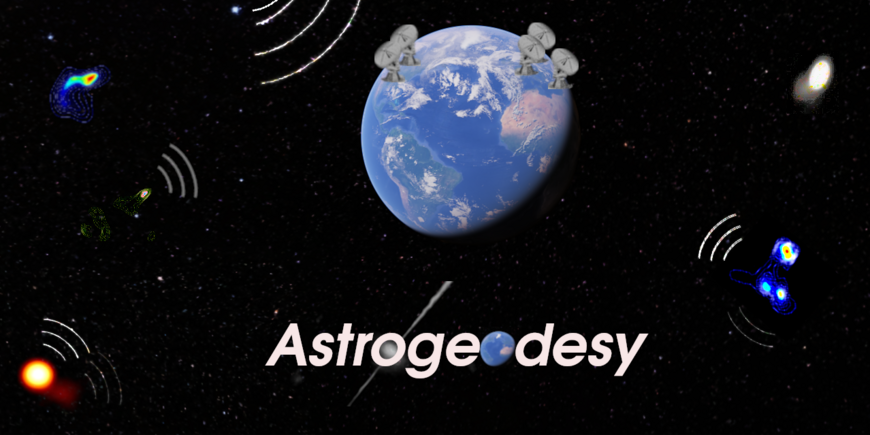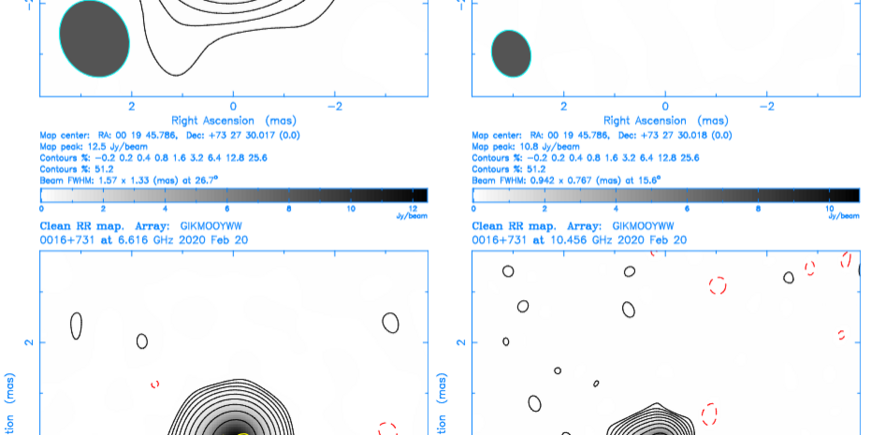Astrogeodesy
Astrogeodesy involves three different fields of study: radio astronomy, astrometry, and geodesy with the new generation of geodetic VLBI system, named VLBI Global Observing System (VGOS) as the backbone. About 30 VGOS antennas have been or are being built across the world with one of the goals to achieve global accuracy of 1 mm for station position and 0.1 mm/year for station velocity, and regular VGOS observations are carried out. It has become clear that the challenge of achieving VGOS goals is the understanding of the true structure of the celestial objects, typically quasar. The radio emission from quasars originates in highly collimated jets of magnetized plasma that are ejected by a supermassive black hole residing at the center of the quasar. Therefore, instead of a point, the quasars have angular structure and the structure evolves with time and frequency. Fortunately the structure images of celestial objects are routinely obtained by the group from the VGOS observations. The Astrogeodesy project, funded by the European Research Council, will connect the three disciplines of geodesy, astrometry, and radio astronomy to solve this challenge.
Astrogeodesy aims to characterize, model, study, and monitor the AGN jets observed by VGOS for achieving high accuracy in stations positions, positions of the AGNs in the sky and Earth Orientation Parameters. Systematic errors due to atmospheric effects are also one of the research topics in the group.
Astrogeodesy Group members
- Minghui Xu, Group leader, and PI of the Astrogeodesy project
- Wara Chamani, Postdoctoral researcher
- Yertay Yaskeliyev, Master student
- Michael Rassokhin, Internship
Selected References
Xu, M., Savolainen, T., Bolotin, S., Bernhart, S., Plötz, C., Haas, R., Varenius, E., Wang, G., McCallum, J., Heinkelmann, R., Lunz, S., Schuh, H., Zubko, N., Kareinen, N. (2023): Baseline vector repeatability at the sub‐millimeter level enabled by radio interferometer phase delays of intra‐site baselines. - Journal of Geophysical Research: Solid Earth, 128, 3, https://doi.org/10.1029/2022JB025198.
Xu, M., Savolainen, T., Anderson, J., Kareinen, N., Zubko, N., Lunz, S., Schuh, H. (2022): Impact of the image alignment over frequency for the VLBI Global Observing System. - Astronomy and Astrophysics, 663, A83, doi.org/10.1051/0004-6361/202140840.
Xu, M., Savolainen, T., Zubko, N., Poutanen, M., Lunz, S., Schuh, H., Wang, G. L. (2021): Imaging VGOS observations and investigating source structure effects. - Journal of Geophysical Research: Solid Earth, 126, 4, doi.org/10.1029/2020JB021238.
Xu, M., Anderson, J., Heinkelmann, R., Lunz, S., Schuh, H., Wan, G. (2021): Observable quality assessment of broadband very long baseline interferometry system. - Journal of Geodesy, 95, 51, doi.org/10.1007/s00190-021-01496-7.
Xu, M., Lunz, S., Anderson, J., Savolainen, T., Zubko, N., Schuh, H. (2021): Evidence of the Gaia-VLBI position differences being related to radio source structure. - Astronomy and Astrophysics, 647, A189, doi.org/10.1051/0004-6361/202040168.
Xu, M., JM Anderson, R Heinkelmann, S Lunz, H Schuh, GL Wang, (2019): Structure effects for 3417 celestial reference frame radio sources. -The Astrophysical Journal Supplement Series 242 (1), 5, doi.org/10.3847/1538-4365/ab16ea.
Anderson, J., Xu, M. (2018): Source Structure and Measurement Noise Are as Important as All Other Residual Sources in Geodetic VLBI Combined. - Journal of Geophysical Research, 123, 11, 10162-10190, doi.org/10.1029/2018JB015550.




